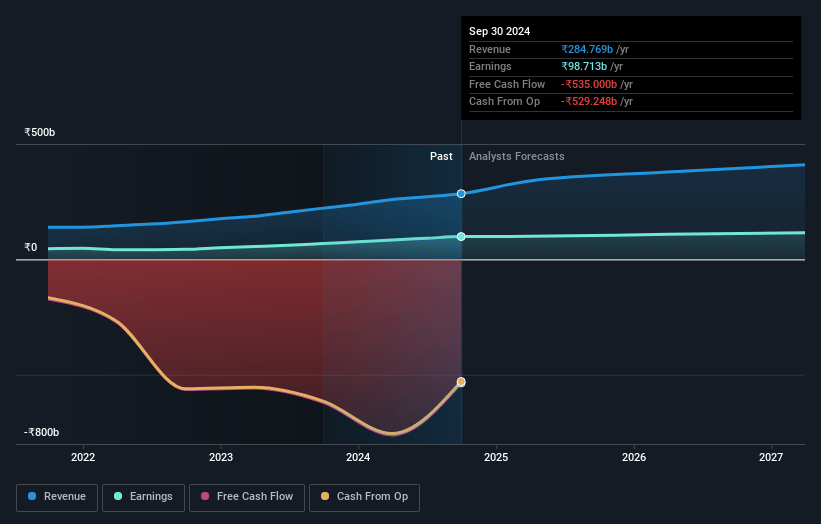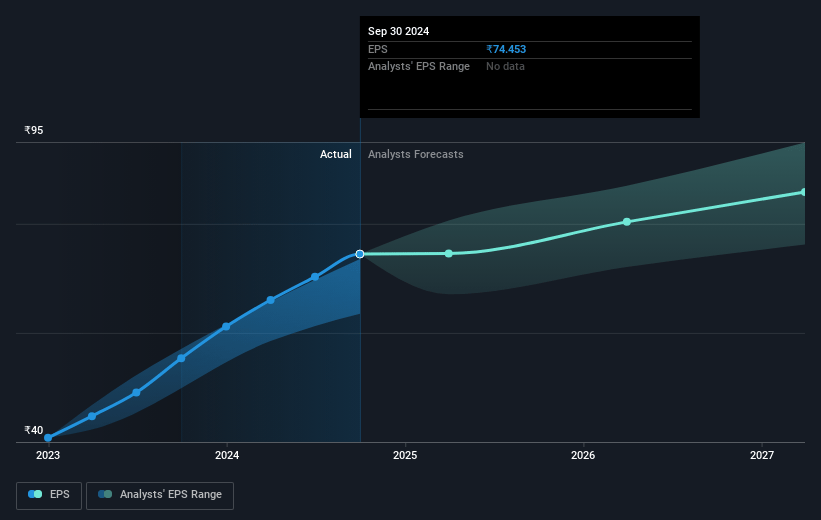Narratives are currently in beta
Key Takeaways
- Digital transformation initiatives and asset quality improvements are set to enhance customer engagement, reduce costs, and boost net margins and profits.
- Strategic growth in credit and robust capital management position the bank for expanded profitable lending and long-term financial stability.
- Slower credit and deposit growth, asset quality concerns, and reliance on borrowings highlight potential long-term profitability vulnerabilities and investor sentiment risk.
Catalysts
About Indian Bank- Provides various banking products and services.
- Digital transformation initiatives, including increased adoption of mobile banking and digital transactions, are expected to enhance customer engagement and lower operational costs, potentially improving net margins.
- A robust recovery strategy from non-performing assets, aiming for ₹7,000 to ₹7,500 crore, may reduce credit costs and positively impact net earnings over time.
- Growth in credit at 12% and the strategic use of infra bonds at favorable rates demonstrate a commitment to expanding profitable lending, with potential for increased net interest income.
- The focus on maintaining a strong capital adequacy ratio (17.84%) ensures financial stability and positions the bank for future growth opportunities, which could enhance long-term earnings.
- Continued improvement in asset quality metrics, including a reduction in net NPAs to 0.27% and a high provision coverage ratio of 97.7%, suggests a decrease in future risk costs, benefiting net profits.
Indian Bank Future Earnings and Revenue Growth
Assumptions
How have these above catalysts been quantified?- Analysts are assuming Indian Bank's revenue will grow by 16.5% annually over the next 3 years.
- Analysts assume that profit margins will shrink from 34.7% today to 26.6% in 3 years time.
- Analysts expect earnings to reach ₹119.9 billion (and earnings per share of ₹86.0) by about January 2028, up from ₹98.7 billion today. However, there is some disagreement amongst the analysts with the more bearish ones expecting earnings as low as ₹103.0 billion.
- In order for the above numbers to justify the analysts price target, the company would need to trade at a PE ratio of 11.3x on those 2028 earnings, up from 7.1x today. This future PE is lower than the current PE for the IN Banks industry at 12.4x.
- Analysts expect the number of shares outstanding to grow by 1.16% per year for the next 3 years.
- To value all of this in today's terms, we will use a discount rate of 14.15%, as per the Simply Wall St company report.
Indian Bank Future Earnings Per Share Growth
Risks
What could happen that would invalidate this narrative?- The growth in credit and deposit rates in the first half of the fiscal year has been slower than expected, raising questions about the bank's ability to meet ambitious end-of-year targets, which may impact future revenue growth.
- An increase in the Special Mention Accounts (SMA), particularly one large government-guaranteed account moving from SMA 2 to SMA 1, could indicate potential asset quality issues that might affect net margins and profits if not resolved quickly.
- Dependence on borrowings rather than deposits for meeting funding needs might suggest cost pressures, as borrowing costs could increase in the future, thereby impacting net interest margins and earnings.
- Potential future write-offs, although decreasing, remain a factor that could affect the bank's provisioning expenses and ultimately net profitability if recoveries do not offset slippages.
- A high dependence on income from provisions and one-off penalties rather than core banking operations might indicate vulnerabilities in sustaining profitability in the long term, which could affect investor sentiment and share price projections.
Valuation
How have all the factors above been brought together to estimate a fair value?- The analysts have a consensus price target of ₹651.82 for Indian Bank based on their expectations of its future earnings growth, profit margins and other risk factors. However, there is a degree of disagreement amongst analysts, with the most bullish reporting a price target of ₹700.0, and the most bearish reporting a price target of just ₹580.0.
- In order for you to agree with the analyst's consensus, you'd need to believe that by 2028, revenues will be ₹450.4 billion, earnings will come to ₹119.9 billion, and it would be trading on a PE ratio of 11.3x, assuming you use a discount rate of 14.2%.
- Given the current share price of ₹517.55, the analyst's price target of ₹651.82 is 20.6% higher.
- We always encourage you to reach your own conclusions though. So sense check these analyst numbers against your own assumptions and expectations based on your understanding of the business and what you believe is probable.
How well do narratives help inform your perspective?
Disclaimer
Warren A.I. is a tool utilizing a Large Language Model (LLM) that ingests data on consensus price targets, forecasted revenue and earnings figures, as well as the transcripts of earnings calls to produce qualitative analysis. The narratives produced by Warren A.I. are general in nature and are based solely on analyst data and publicly-available material published by the respective companies. These scenarios are not indicative of the company's future performance and are exploratory in nature. Simply Wall St has no position in the company(s) mentioned. The price targets and estimates used are consensus data, and do not constitute a recommendation to buy or sell any stock, and they do not take account of your objectives, or your financial situation. Note that Warren A.I.'s analysis may not factor in the latest price-sensitive company announcements or qualitative material.
Read more narratives
There are no other narratives for this company.
View all narratives



